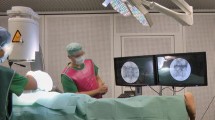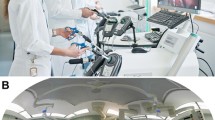Abstract
Purpose
To design a surgical training environment based on task and crisis analysis of the surgical workflow.
Method
The environment consists of: (1) real surgical instruments that are augmented with realistic haptic feedback and VR capabilities, (2) human sensory channels such as tactile, auditory and visual in real time, and (3) the ability to facilitate deliberate exposure to adverse events enabling mediation of error recovery strategies.
Validation
Five surgeons were immersed in our medical simulation environment through task and crisis scenarios of a typical vertebroplasty workflow.
Results
Based on a five-point Likert-scale survey, the face validity of our simulation environment was confirmed by investigating surgeon behavior and workflow response.
Conclusions
The result of the conducted user-study corroborates our unique medical simulation concept of combining VR and human multisensory responses into surgical workflow.







Similar content being viewed by others
References
Rodriguez-Paz JM, Kennedy M, Salas E, Wu AW, Sexton JB, Hunt EA, Pronovost PJ (2009) Beyond see one, do one, teach one: toward a different training paradigm. Quality Saf Health Care 18(1):63–68
Kneebone R (2010) Simulation, safety and surgery. Quality Saf Health Care 19(3):i47–i52
Lateef F (2010) Simulation-based learning: just like the real thing. J Emerg Trauma Shock 3(4):348–352
Gallagher AG, O’Sullivan GC (2012) Fundamentals of surgical simulation principles and practices. Springer, London
Grantcharov TP, Kristiansen VB, Bendix J, Bardram L, Rosenberg J, Funch-Jensen P (2004) Randomized clinical trial of virtual reality simulation for laparoscopic skills training. British J Surg 91(2):146–150
Safar P, Brown TC, Holtey WJ, Wilder RJ (1961) Ventilation and circulation with closed-chest cardiac massage in man. JAMA 176(7):574–576
Gordon MS (1974) Cardiology patient simulator: development of an animated manikin to teach cardiovascular disease. Am J Cardiol 34(3):350–355
Gaba DM, DeAnda A (1988) A comprehensive anesthesia simulation environment: re-creating the operating room for research and training. Anesthesiology 69(3):387–394
Fritz PZ, Gray T, Flanagan B (2008) Review of mannequin-based high-fidelity simulation in emergency medicine. Emerg Med Australas 20(1):1–9
Rosen KR (2008) The history of medical simulation. J Critical Care 23(2):157–166
Devitt JH, Kurrek MM, Cohen MM, Fish K, Fish P, Noel AG, Szalai JP (1998) Testing internal consistency and construct validity during evaluation of performance in a patient simulator. Anesth Analg 86(6):1160–1164
Devitt JH, Kurrek MM, Cohen MM, Cleave-Hogg D (2001) The validity of performance assessments using simulation. Anesthesiology 95(1):36–42
Cooper JB, Taqueti VR (2008) A brief history of the development of mannequin simulators for clinical education and training. Postgrad Med J 84(997):563–570
Heng P-A, Cheng C-Y, Wong T-T, Yangsheng X, Chui Y-P, Chan K-M, Tso SK (2004) Virtual reality based system for training on knee arthroscopic surgery. Stud Health Technol Inform 98:130– 136
Chui C-K, Ong JSK, Lian Z-Y, Wang Z, Teo J, Zhang J, Yan C-H, Ong S-H, Wang S-C, Wong H-K, Teo C-L, Teoh S-H (2006) Haptics in computer-mediated simulation: training in vertebroplasty surgery. Simul Gaming 37(4):438–451
Fargen KM, Siddiqui AH, Veznedaroglu E, Turner RD, Ringer AJ, Mocco J (2011) Simulator based angiography education in neurosurgery: results of a pilot educational program. J NeuroIntervent Surg 4(6):438–441
Seymour NE, Gallagher AG, Roman SA, O’Brien MK, Bansal VK, Andersen DK, Satava RM (2002) Virtual reality training improves operating room performance. Ann Surg 236(4):458–464
Ahlberg G, Enochsson L, Gallagher AG, Hedman L, Hogman C, McClusky DA III, Ramel S, Smith CD, Arvidsson D (2007) Proficiency-based virtual reality training significantly reduces the error rate for residents during their first 10 laparoscopic cholecystectomies. Am J Surg 193(6):797–804
Cumin D, Boyd MJ, Webster CS, Weller JM (2013) A systematic review of simulation for multidisciplinary team training in operating rooms. Simul Healthc 8(3):171–179
Schout B, Hendrikx A, Scheele F, Bemelmans B, Scherpbier A (2010) Validation and implementation of surgical simulators: a critical review of present, past, and future. Surg Endosc 24(3):536–546
Rodgers DL (2007) High-fidelity patient simulation: a descriptive white paper report
Wucherer P, Stefan P, Weidert S, Fallavollita P, Navab N (2013) Development and procedural evaluation of immersive medical simulation environments. In: Information processing in computer-assisted interventions, pp 1–10
Krueger A, Bliemel C, Zettl R, Ruchholtz S (2009) Management of pulmonary cement embolism after percutaneous vertebroplasty and kyphoplasty: a systematic review of the literature. Eur Spine J 18(9):1257–1265
Ploeg WT, Veldhuizen AG, The B, Sietsma MS (2006) Percutaneous vertebroplasty as a treatment for osteoporotic vertebral compression fractures: a systematic review. Eur Spine J 15(12):1749–1758
Freitag M, Gottschalk A, Schuster M, Wenk W, Wiesner L, Standl TG (2006) Pulmonary embolism caused by polymethylmethacrylate during percutaneous vertebroplasty in orthopaedic surgery. Acta Anaesthesiol Scand 50(2):S248–251
Wang LJ, Yang HL, Shi YX, Jiang WM, Chen L (2012) Pulmonary cement embolism associated with percutaneous vertebroplasty or kyphoplasty: a systematic review. Orthop Surg 4(3):182–189
Barr J, Resnick D (2005) Vertebroplasty and Kyphoplasty. Thieme Medical Publishers, Stuttgart
Martin S, Hillier N (2009) Characterization of the Novint Falcon haptic device for application as a robot manipulator. ACRA Proceedings, Sydney
Ra JB, Kwon SM, Kim JK, Yi J, Kim KH, Park HW, Kyung K-U, Kwon D-S, Kang HS, Kwon ST, Jiang L, Zeng J, Cleary K, Mun SK (2002) Spine needle biopsy simulator using visual and force feedback. Comput Aided Surg 7(6):353–363
Pettersson J, Palmerius KL, Knutsson H, Wahlstrom O, Tillander B, Borga M (2008) Simulation of patient specific cervical hip fracture surgery with a volume haptic interface. IEEE Trans Biomed Eng 55(4):1255–1265
Palmerius KL, Gudmundsson B, Ynnerman A (2005) General proxy-based haptics for volume visualization. In: Proceedings of the world haptics conference, pp 557–560
Ruspini DC, Kolarov K, Khatib O (1997) Haptic interaction in virtual environments. In: Proceedings of the IEEE-RSJ international conference on intelligent robots and systems, pp S128–S133
Rossignac J, Megahed A, Schneider B (1992) Interactive inspection of solids: cross-sections and interferences. In: Proceedings of ACM Siggraph, pp 353–360
McReynolds T, Blythe D, Grantham B, Nelson S (1998) Advanced graphics programming techniques using OpenGL. In: SIGGRAPH’98 course notes, pp 15–16
http://glbook.gamedev.net/GLBOOK/glbook.gamedev.net/moglgp/advclip.html
Astle D (2006) More OpenGL game programming. Thomson/Course Technology, Boston, MA
Conflict of interest
Patrick Wucherer, Philipp Stefan, Simon Weidert, Pascal Fallavollita and Nassir Navab declare no conflict of interest.
Author information
Authors and Affiliations
Corresponding author
Additional information
P. Wucherer and P. Stefan have equal first authorship.
Rights and permissions
About this article
Cite this article
Wucherer, P., Stefan, P., Weidert, S. et al. Task and crisis analysis during surgical training. Int J CARS 9, 785–794 (2014). https://doi.org/10.1007/s11548-013-0970-z
Received:
Accepted:
Published:
Issue Date:
DOI: https://doi.org/10.1007/s11548-013-0970-z




